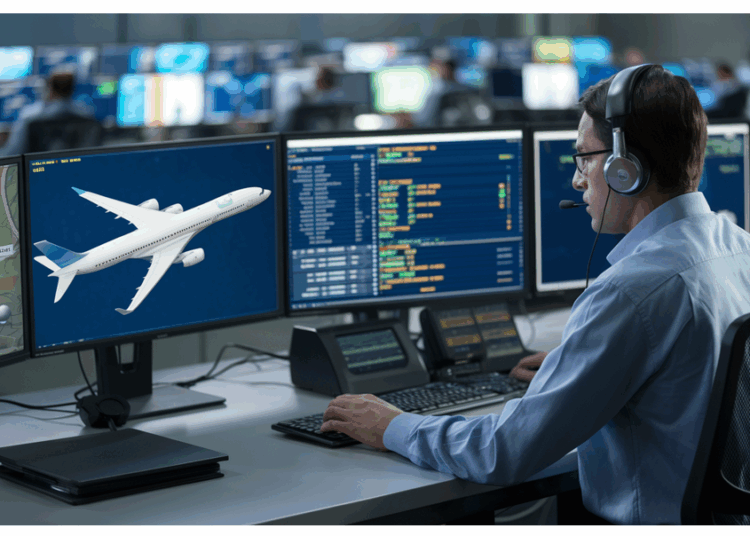Imagine this
A busy international airport on a Monday morning. Hundreds of flights scheduled, thousands of passengers in transit. Suddenly, the radar systems go dark for two minutes. Panic spreads through the control tower. The screens light up again, but now several aircraft appear to be flying the same route. Confusion reigns. A cyberattack has spoofed the data fed into the air traffic management (ATM) system. Lives are at risk and no one saw it coming.
This may sound like fiction, but it’s a growing concern in today’s connected world. As aviation becomes more digital, it also becomes more vulnerable. Cybersecurity in air traffic management is no longer a technical issue. It is a safety issue.
Why Cybersecurity in Air Traffic Management Matters
Air traffic management systems control how planes take off, land, and move through the sky. These systems rely on radar, GPS, communication tools, and decision-making software to keep aircraft safe and organized.
But these same systems are also connected to the internet, use open communication protocols, and depend on complex software. That makes them a target for cybercriminals, hostile nations, and even rogue hackers who want to cause chaos.
In 2021, Europe’s air traffic control agency, Eurocontrol, was hit by a ransomware attack. Although no flights were grounded, it showed how exposed the aviation sector is. A similar attack with a deeper reach could delay flights, mislead pilots, or cause airspace to shut down.
How Hackers Can Attack ATM Systems
There are many ways cyberattacks can affect air traffic systems. Some of the most common methods include:
- GPS Spoofing: This tricks an aircraft into thinking it is somewhere else.
- ADS-B Interference: Aircraft broadcast their position through a system called ADS-B. Since this data is not encrypted, it can be altered or faked.
- Jamming: Attackers can block or scramble signals between aircraft and control towers.
- Malware in Control Systems: Just like your computer, air traffic systems can get infected with malicious software.
- Insider Threats: Sometimes, people with access to sensitive systems may cause harm—either by accident or on purpose.
Each of these methods can create confusion and danger in the skies. Even small disruptions can have major consequences.
The Bigger Picture: Global Systems, Shared Risks
One challenge is that air traffic systems are not managed by one organization. Each country has its own agencies and rules. Yet, planes fly across borders every day. This means one weak link in the chain can affect the entire global air traffic network.
For example, if a cyberattack targets a smaller country with limited cybersecurity resources, that attack can ripple out to neighboring countries through connected systems. That’s why collaboration and shared knowledge are essential.
What the Future Looks Like
The good news is that the aviation world is waking up. New ideas and technologies are being developed to stay ahead of cyber threats.
Here are some promising steps forward:
- Artificial Intelligence for Threat Detection: AI can monitor systems in real time, spot unusual activity, and raise alarms before damage is done.
- Zero Trust Architecture: This security model assumes nothing is safe, even inside the network, and constantly checks and verifies every action.
- Quantum Encryption: Though still in development, this could offer powerful protection against future cyber threats.
- Digital Twins: Some airports and ATM systems are using digital twins—virtual copies of real systems—for testing and spotting vulnerabilities before hackers find them.
- Secure Satellite Communication: Shifting from ground-based systems to space-based platforms can offer extra layers of protection.
But even the best tools mean little without a plan and the will to act.
A Global Action Plan
Here’s what needs to happen next:
- Mandatory Cybersecurity Audits: All air traffic organizations should regularly test their systems for weaknesses.
- Training for Staff: Everyone from engineers to controllers should understand basic cybersecurity principles.
- Real-Time Global Threat Sharing: Nations and aviation bodies must share data about cyber threats instantly.
- Updated Regulations: Laws need to reflect modern risks and require minimum cybersecurity standards.
- Emergency Backup Systems: If digital systems fail, there should always be a safe fallback option.
Cybersecurity should be treated the same way airlines treat maintenance. It must be routine, constant, and taken seriously.
What Happens If We Don’t Act?
Cyberattacks are not a question of “if,” but “when.” If we wait, the damage could be deadly. Flight delays are one thing, but a mid-air collision caused by false data would be a tragedy.
The cost of doing nothing is simply too high. The skies may look peaceful, but behind every safe flight is a complex web of systems that must be protected.
Protecting the Skies Starts on the Ground
Air traffic management is one of the most important and sensitive systems in the world. It guides millions of people safely through the air every day. But as it grows smarter and more connected, it also becomes a bigger target.
Cybersecurity is no longer an extra layer. It is now part of the foundation. By preparing today, the aviation industry can stay one step ahead of the threats of tomorrow.
Because in the sky, mistakes can’t be undone. And in the world of air traffic, safety begins with strong systems, and even stronger defenses.





